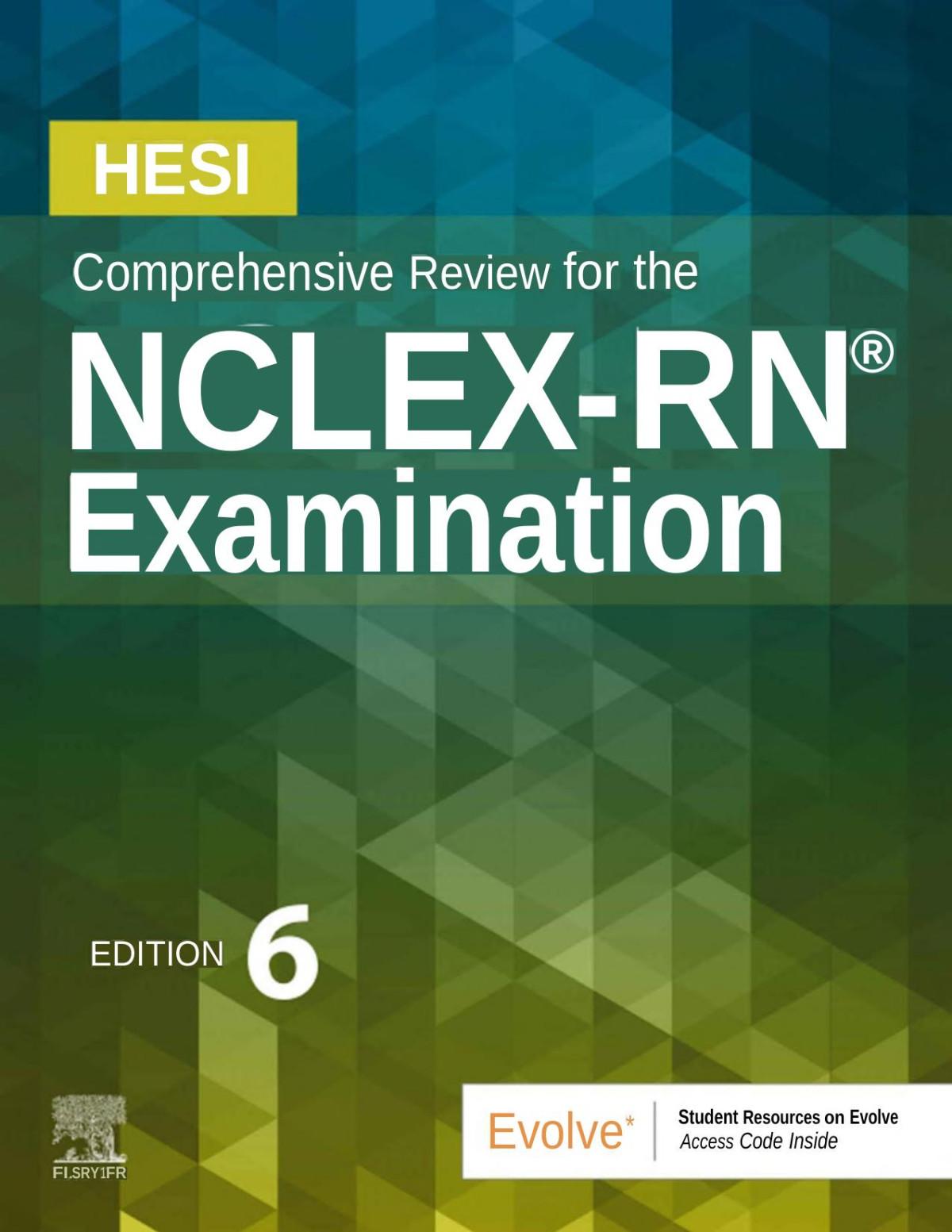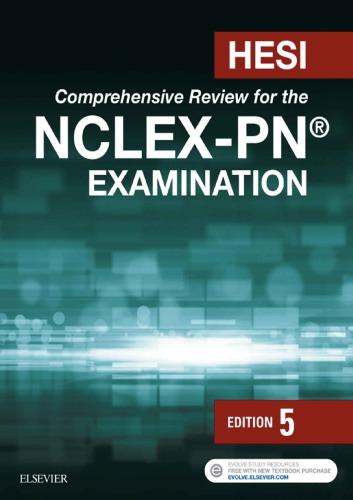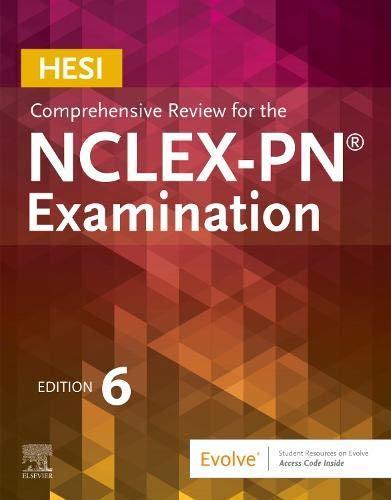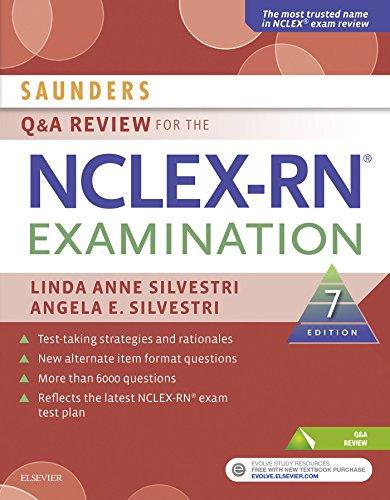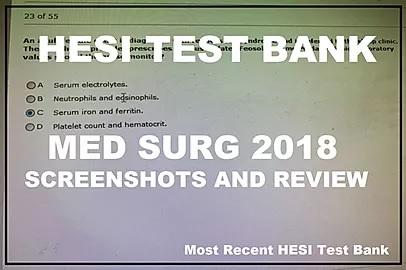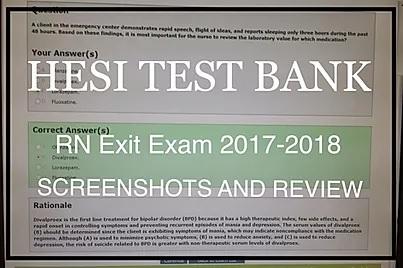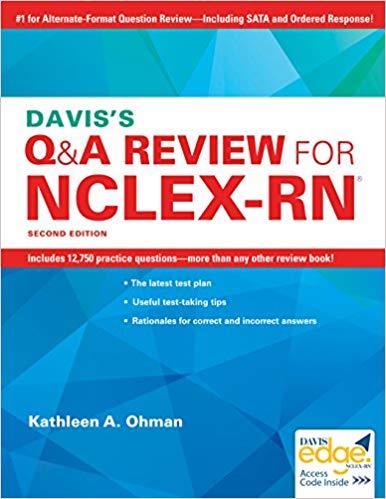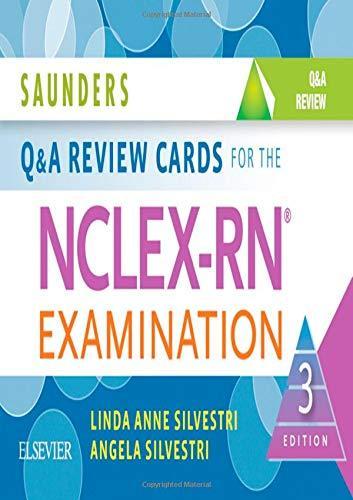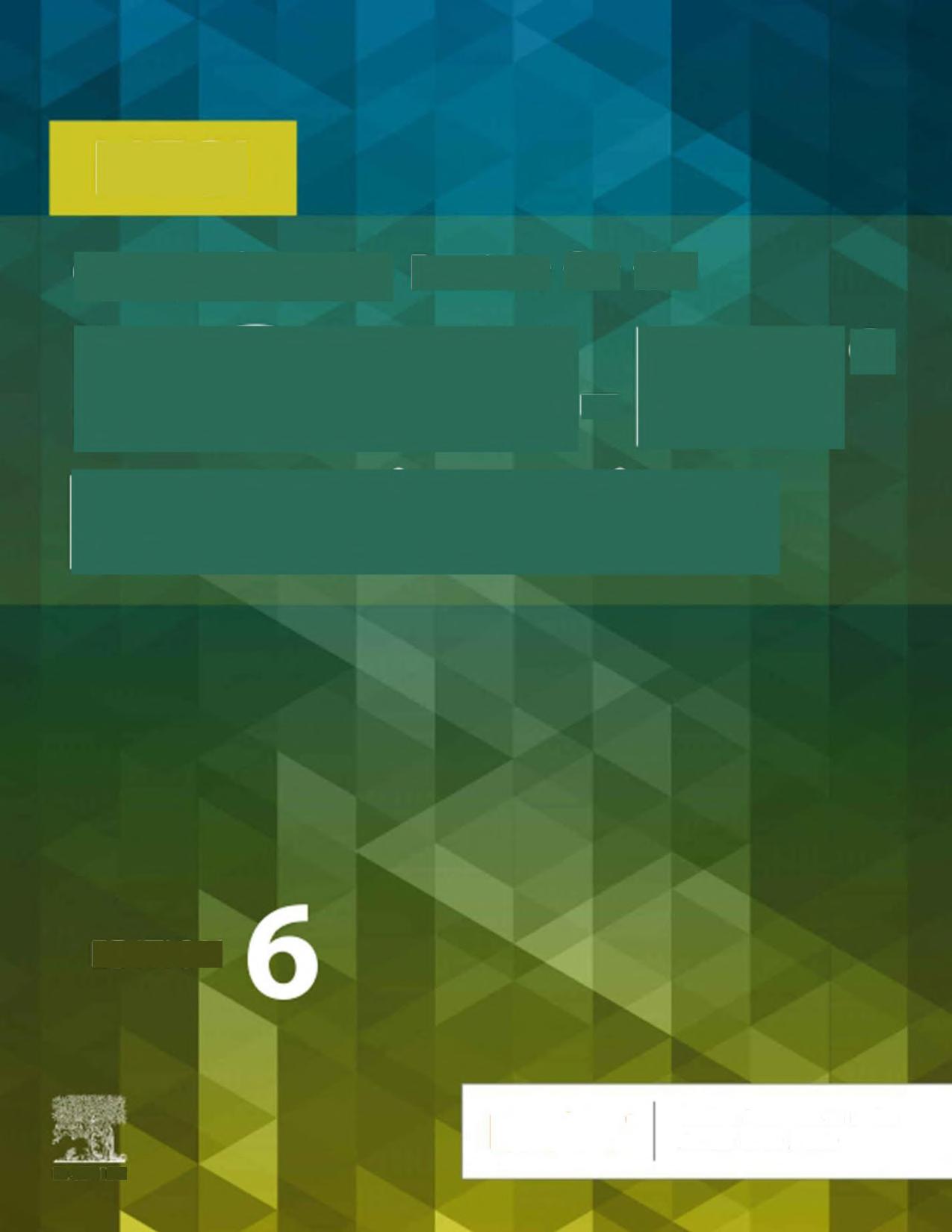Next Generation NCLEX and Clinical Judgment
Starting in July of 2017, the National Council of State Boards of Nursing (NCSBN) began including a special research section to select candidates after they complete the exam. The data collected from this section is used to help determine new item types that may be included in a future version of the NCLEX, known as Next Generation NCLEX (NGN). (More information can be found at ( http://www ncsbn org/next-generationnclex.htm. ) An important piece of the NGN is the clinical judgment model. Clinical judgment is important for all nurses, and this book helps nursing students by reviewing information and skills that nurses must master to practice clinical judgment. Additionally, NCLEX practice questions on the Evolve website written at higher levels of Bloom’s taxonomy help students practice applying their clinical judgment knowledge. Finally, a Clinical Judgment Scenario with practice NGN questions is included in Chapter 4 to familiarize students with these types of questions
Another random document with no related content on Scribd:
Loi Pah Kung, “the mountain of the tiger’s head,” 76.
Loi Panya Lawa, 395.
Loi Poo-ay, 153.
Loi Pwe, 46.
Loi Saun-Ka-tee, 205.
Loi Soo Tayp mountain, 91 —ascent of, 120.
Loi Ta Khan Lai, 74.
Loi Tat Muang Ken, 368.
Loi Tong Wai, 46, 47.
Loi Too-ey, 329.
Loi Wung Ka Chow, 402.
Lolo and Kaun villages, 365.
Lotus, use of the, as a symbol, 51.
Lover’s lute, description of a, 386.
Luang Prabang, 21, 135, 321.
MacLeod’s, General, journey to China through Burmah, viii.
M‘Gilvary, Dr and Mrs, 94—the Doctor joins the exploring party, 123 —sermon to the people by, 333.
Madras boys good fighters, 7 —their honesty, 128.
Maing Loongyee, 16, 24, 27 —its watersupply, 31.
Manners, learning, 304.
Maps of the country, 332.
Market at Zimmé, 100 —great variety of wares at, ib.
Markets, need for new, 415.
Marriage customs, 174—curious, 366.
Martin, Rev. Mr, 94 —joins party, 313 et seq.
Mau Sau, a celebrated native hunter, 353.
Maulmain thoroughfare, 4.
Maung Doo, halt at, 127.
Maung Fang, leave for, 315.
Maung Haut, 61 —party leaves, 69.
Maung Hit, excursion to, 196.
Maung Kent, 328.
Maung Pan, state of, 156.
Meals, 84 —daily particulars of, 249.
Medicine and pills, theft of, 383.
Medicines, stock of, 6 —Siamese, 174, 273 —ingredients in a dose, 274.
Meh Ai, the river of shame, 346.
Meh Chan, 351.
Meh Chun valley, 76.
Meh Fang, 341 —camping at, 344 —river, 360 —valley of the, 75.
Meh Gat, 42.
Meh Hang, 329, 341.
Meh Hau Prat, stream, 44, 370.
Meh Haut river, 61.
Meh Hkort valley, 136.
Meh Hkuang, 392.
Meh Hkuang river, 88, 127, 288.
Meh How river, 284.
Meh Hto river, 48.
Meh Ing, 153.
Meh Ing river, 225, 247.
Meh Ka, 91.
Meh Ka Lah, 136.
Meh Ka Ni, 42.
Meh Ka Tone, 27.
Meh Kang, 74, 135.
Meh Kee-ow, 309.
Meh Khan, 87.
Meh Khoke plain, 165.
Meh Kok, 27, 135.
Meh Kong or Cambodia river, 21, 156, 224 —great eastern bend of the, 190.
Meh Kong valley, 23.
Meh Lah river, 255.
Meh Lai, 393.
Meh Lai river, 45.
Meh Laik river, 24, 44.
Meh Li, 75.
Meh Lim, 320.
Meh Low, 88
—hot springs of, 311 —valley of the, 308.
Meh Lye, 44.
Meh Mau river, 256.
Meh Nam delta, population of the, 460.
Meh Nam river, navigation on the, 250, 441 et seq.
Meh Ngat, crossing the, 363 —defile of the, 368.
Meh Ngor river, 21, 24 —its width and depth, 26.
Meh Ngow, arrival of expedition at, 252 —description of the city of, 253.
Meh Nium river, 20, 21, 24, 31.
Meh Nium valley, 44.
Meh Pai, 353.
Meh Pa-pai, 60.
Meh Pau, a tributary of the Thoungyeen river, 17.
Meh Phit, 75.
Meh Pik, or the Pepper river, 147.
Meh Ping, 64, 127, 320, 330 —sources of the, 328.
Meh Poi, 341.
Meh Sa river, 320.
Meh Sa Lin river, 31, 42.
Meh Soo-ay, a royal game-preserve, 147.
Meh Sow river, 287.
Meh Ta, valley of the, 88, 287.
Meh Ta Loke, 360.
Meh Tan, 393.
Meh Teng valley, 329.
Meh Teun, 393.
Meh Tha Wah, 18, 23.
Meh Too, 23.
Meh Trien, valley of the, 283.
Meh Tyen, 48.
Meh Wung, 141 —valley of the, 251 —villages on the, 278 —crossing the, 283 —basin of the, 309 —mouth of, 403.
Meh Yee-ep, 393.
Meh Yom, 439.
Meh Yu-ek, 251.
Mehongson, 353.
Merchandise brought by Chinese traders, 213.
Mha Tha Ket, 48.
Meh Wung, 404.
Mineral springs, 24.
Missionaries approve of the extension of the railway system, 96 —friendly footing of, 205 —illness of, 363.
Missionaries bad sportsmen, 357.
Missions, promising field for, 389.
Mokmai, a Burmese Shan State, 334.
Mon race and language, the, xi.
Monasteries in Maing Loongyee, 31.
Monastery, visit to a, 78.
Monastic life, entering, 337.
Moné, the chief of, subject to Great Britain, 157.
Mong Hpai, 432.
Mong Nai, 432.
Monk spoilt by the ladies, 165.
Monks, evil practices of, 301.
Monopolies, effect of, 365.
Monosyllabic languages, 161.
Moonlight scene, a, 330.
Moung Loogalay, 326.
Mountain villages of the Khas, 21.
Moway, famous quarries of, 300.
Muang Fang, 337 —arrival at, 347 —description of, ib. —population of, 349 —history of, 353 —cost of carriage to, ib. —leave the city, 360.
Muang Hăng State, 335.
Muang Haut, 295, 392.
Muang Hpan, 223.
Muang Ken, 368.
Muang Ko, 437.
Muang La Maing, 120.
Muang Len, 426.
Muang Ngai burned, 335 —the city of, 338.
Muang Ngam, 350.
Muang Ngow city, 245.
Muang Nium principality, 30.
Muang Nyon, 350.
Muang Penyow, 229.
Muang Phan, 221.
Muang Sat, 350.
Muang Soon Dok, the town of the flower-garden, 120.
Mud, boiling, to make tea, 225.
Musical water-wheels, 89.
Myawadi, 419.
Naiads, offerings to the, 259.
Nam Proon, 432.
Needlework, fancy, 103.
Neis, Dr Paul, French navy, 135 —his survey for a railway route, 278.
New Htow, 394.
Nga-peur-dau village, 14.
Ngio (Burmese Shans) raids, 365.
Ngio, or Moné Shans, 158.
Ngu race, xi.
Nirvana, the state of, 337.
Nong Doo Sakan, 88.
Nong Hang, 225.
Nong Sang, 89.
Nong Vee-a plain, 342.
Offerings to the dead, 17, 147 —for the monks, 257 —to the spirits of the land or rivers, 259 —to the good influences, 373.
Ogres, Madras boys taken for, 167.
Oo-caw stream, 24.
Ootaradit, 441.
Organ or pipes, the Laos, 339.
Oxen used for drawing timber, 308.
Paddy-birds, flocks of, 209.
Pagoda, a fine, 91 —of the Emerald Rice-bowl, 121 —on Loi Tee, 288.
Pahpoon, 33.
Pah Took, 255.
Pa-kin-soo, 392.
Pak Bong, 88.
Pak Muang, 90.
Pak Nam Po, 441, 442.
Palace at Zimmé, 101.
Palace of the angels, description of the, 324.
Palmyra-trees, 401.
Pang Eemoon, swampy valley of, 60.
Pang Hpan, 43.
Pang Ngao, village of, 225.
Pang Pau, 341.
Pa Sang, 88.
Pass 6500 feet above the sea, 156
—a dangerous, 287
—a difficult, 342.
Passports supplied to the exploring party, 125.
Paths over the hills, nature of the, 36.
Patriarch, family, 129.
Pau-ku-lay Toung, 17.
Pau Pa Teun, 177.
Pedlars, Burmese, 253.
Penyow, 224
—expedition leaves, 246.
Peoples, Dr, 112 et seq.
Petchaburi, governor of, 407.
Petroleum at Kiang Dow and Muang Fang, 333.
Petticoats, purchasing, 392.
Phayre, Sir Arthur, on British interests in Siam, 421.
Phichai, 441.
Photographic apparatus spoiled, 20.
Phya Khrut or Garuda, the king of eagles, 234.
Pigs, wild, ravages of, 186.
Pillar-Rock, 401.
Ping Shans, 49.
Plain, a beautiful, 364.
Plants, dangerous, in the jungle, 361.
Play, a Shan, 338.
Poayhla, 430, 432.
Portuguese ousted from Burmah, vii.
Pottery, manufacture of, 233.
Prayers, chanting, 452.
Prices of various articles at Maulmain, Bangkok, and Zimmé, 296.
Primitive pagoda, a, 308.
Prince, an intelligent, on the best railway route, 143.
Princes in their best clothes, 154.
Princess trader, visit to a, 103 —her opinion on the proposed railway, ib. —friend to the missionaries, 117.
Principality, ancient, of Hsen, 200.
Prisdang’s, Prince, letter, 114.
Prison of Bangkok, 451.
Prisoners in chains sawing timber, 102.
Procession of exploring party when entering Kiang Hai, 154.
Propitiation of spirits, 179.
Provisions, out of, 358.
Punishments in the Buddhist hells, 263.
Purchas’s visit to Zimmé, vii.
Quambee, 10.
Quanta, 3.
Quinine, value of, 363.
Races, separation of, in the cities, 352.
Rachel, a Shan, 228.
Raheng, 15 —the White Elephant route to, 278 —reach, 404 —leave, 435.
Railway communication, proposed branch line from Yembine to Tehdau-Sakan, 1
—proposed route of railway from Maulmain, 48
—paths for a railway, 56, 75
—discussion with the King of Zimmé about the railway, 102
—suggested route, 143
—road for a line to China, 151
—Dr Cheek on the prospects of a Burmah-China railway, 170
—branch line to Muang Fang, 184
—benefits of opening up the country by, 196
—chief’s opinion regarding labour, &c., for constructing, 214
—loop-line to Zimmé, 215
—proposed route to Muang Phan, 222
—importance of Penyow in regard to, 232
—route along the valley of the Meh Wung, 251
—how to tap the trade of Muang Nan and Muang Peh, 252
—proposed line from Bangkok viâ Lakon, 255
—Dr Neis on the railway connection of Burmah and China, 278
—cheap labour for the railway, 281
—desire for the projected railway, 292
—a branch line from Lakon, 309
—line from Zimmé to Kiang Hsen, 361
—talk with Prince Bigit on the subject of railways, 381
—routes for the railway, 403
—importance of connecting India with China, 415
—the Indo-Burmese and Burmo-Chinese projects, 416 et seq.
—advantages of Maulmain as a terminus, 417
—the Siamese route to Raheng, 418
—Sir Charles Bernard and other authorities on the projected routes, 419 et seq.
—character of the Bhamo route, 429
—the Maulmain or nothing, 433
—commercial importance of the proposed railway, 434
—resolutions of Chambers of Commerce on the Burmah-SiamChina Railway, 464 et seq.
Rain-god Indra, descent of the, 260.
Rangoon and Mandalay railway, 14.
Rapids shooting, dangerous, 395 et seq.
Raspberries, wild, 46.
Rebellion of the Zimmé Shans against Burmah, 88.
Religious buildings erected by the Burmese, 124 —ruined, 355.
Rénan’s, Ernest, ‘New Studies of Religious History’ quoted, p. 57, note.
Responsibility of villagers for loss and crime in their district, 139.
Rice-plain, a large, 179.
Rice-plain of Zimmé, 127 —export of, from Penyow to Lakon, 231.
Richardson, Dr, viii.
—his visit to Maing Loongyee in 1829, 30.
Ringworm, 192.
River, a filthy, 230.
Robbing an image, 198.
Romantic princess, a, 117.
Roses, wild, 247.
Routes from China, 213.
Rubies, searching for, 403.
Ruby-mines, 61, 266.
Ruins of temples, extensive, near Kiang Hsen, 193.
Russia and Siam, comparison between, 297.
Russian railway across Asia, projected, 420.
Sacred cave of Tum Tap Tow, 342.
Sacred hills, 182.
Sacrifices to evil spirits, 22
—to ancestors and demons, 52.
Salt used as currency in the Zimmé market, 164.
Salween mountain, 329.
Salween river, 3, 10.
Sambhur deer, a, 403.
Samuel, Thomas, first English visitor to the Shan States, vii.
Sapphire-mines, 462.
Satow, Mr, British consul-general in Siam, 419.
Sawankalok, 439.
Scott, Mr (Shwé Yoe), on religious tortures, 380, 445.
Service, evening, in a temple, 316.
Settlements, formation of, 220 —method of forming new, 350.
Sgau Karens, 17.
Shadow spirit, the, 83.
Shan dynasties in Burmah, 82.
Shan ladies, visit to, 321.
Shan language and its dialects, 312.
Shan Queen in English dress, 119.
Shan race, xv.
Shan States or kingdoms, 32.
Shans bartering goods, 46.
Shaving the head and eyebrows, 304.
Shoaygoon, 1, 3.
‘Siam and Laos,’ by Dr Cheek, quoted, 170.
Siam, British stake in, 420.
Siam railways need high embankments, 411.
Siamese authorities, apathy of, 390.
Siamese Commissioner, visit the, 113.
Siamese, description and dress of, 113.
Siamese frontier post, 20.
Siamese history, early, xiii.
Siamese officials expect bribes, 19.
Silk-cotton trees, 71.
Silver coinage in use, 163.
Silver-mines, 75, 403.
Siva worship, 319.
Sketching the scenery of the country, 64.
Slave-bondage, 131.
Slavery, gambling a cause of, 238 —the law of Siam, regarding, ib. —parents selling children into, 240.
Slavery in Bangkok, 452.
Slaves, price of, 31, 130 —purchased from Red Karens, 388.
Smallpox, outbreak of, 28 —outbreak of, in Penyow, 232 —callousness of natives as to, 233.
Smith-work of the Shans, 55.
Snake, sitting on a, 362.
Snake-worship, 318.
Soil and foliage, 146.
Song Kare, 91.
Song Kweh, 400.
Soom Cha, 402.
Spinning-wheels, emigrants carrying, 363.
Spirit-clans, formation of, 396.
Spirit-medium, a, 105.
Spirit-worship of Ping Shans, 373.
Spirit-worshippers, 15.
Spirits alluring travellers, 398.
Springs, hot, 340.
Ssumao, a Chinese frontier post, 151.
Stone images of Buddha, 233.
Stork, King, 448.
Story of a yak, 59.
Story of the peacock and crow, 63.
Straining water, 323.
Street, Colonel, 48.
Subterranean channels, 24.
Sugar-press, a simple, 74.
Suicide by no means unusual, 152.
Sukkhothai, 439.
Sunday service by Dr M‘Gilvary, 216.
Superstition, degrading influence of, 82.
Survey of passes between Siam and Burmah, 391.
Surveying, 9 —under difficulties, 139.
Surveys made for the King of Siam by English engineers for railways, 196.
Sworn brothers, 354.
Ta Kwai village, 90.
Ta Nong Hluang ferry, 71.
Ta Nong Pai, 91.
Ta Pa or “rock-ferry,” 73.
Ta Pwee ford, 402.
Ta Wang Pow, 89.
Tai Ngio people, 157.
Tali-foo, 427.
Tattooing, practice of, 138.
Taxation in Siam, vexatious, 447.
Taxation, light, 135 —burdensome, in Siam, 244 —light, in Shan States, 245.
Taxes in Kiang Hai, 163.
Tea-growing on the hills to the west of Meh Ping, 369.
Tea, wild, plant, 24, 320.
Teaching in a monastery, 304.
Teak-forests in the Thoungyeen valley, 21 —forests belong to chiefs, 135 —forests, 198.
Teak-trees, 10 et seq.
Tee-tee-ko, 16.
Teh-dan-Sakan, 12, 14, 16.
Temple, Shan description of a, 66.
Temple, Sir Richard, on the proposed railway to China, 424.
Tenasserim division of Burmah, 1.
Thatone, 4.
Thoungyeen river, 10–16, 20 et seq.—, 405.
Thoungyeen valley, 21.
Thunderstorm, tremendous, 281.
Tigers, scaring, 137 —prowling of, 179.
Timber king, a, and the money-lenders, 28.
Tobacco, cutting, 57 —caravan laden with, 346.
Tobacco-gardens, 70.
Toon Chang, 460.
Torture at the police courts, 450.
Tower muskets in use, 311.
Trade and traffic of Zimmé, 104.
Trade between British Burmah and Siam, and its Shan states, 117.
Trade-routes, intersection of, at Kiang Hsen, 195 —to Penyow, 232.
Trading caravan, a, 11.
Transmigration of the soul, belief in the, 112.
Travellers delayed, 296.
Tree-ferns, 44.
Trees inhabited by spirits, 110.
Trial by water, 260.
Trichinosis, 346.
Tricks with the currency, 164, 165.
Tsin-sway, or Elephant-tusk stream, 23.
Tum Kwan, ceremony of, 373.
Tutelary gods, belief in, 231.
Underground rivers, 395.
Venison for dinner, 15.
Viang Chai, 336.
Viang Chaum Taung, 227.
Viang Ma-nee-ka, 345.
Viang Moo Bom, city of, 228.
Viang Pa Pow, 142, 307.
Viang Pow, 353 —surrounded by a palisade, 364 —population of, 365 —cost of carriage to, 366 —trade-routes from, ib.
Villages swept away by floods, 412 —a line of, 444.
Wages of boatmen, 66.
Wang Hluang Pow, 87.
War-paths leading from Burmah to Zimmé and Siam, 30.
Warming of Buddh, the, 265.
Waterfalls, high, 42, 397.
Water festival at the New Year, 265.
Water-parting between the Meh Ping and Meh Kong, 360.
Water-wheels, 75.
Wat Phra Chow Toon Hluang, 227.
Webster, Rev. David, American Baptist Mission, 19 et seq.—390.
Whistling rockets, 219.
White Elephant, temple of the, 315.
Wilson, Rev. Jonathan, 96.
Witch villages, 143.
Witchcraft, spirit of, 106 —false charges of, 109
—action of missionaries with respect to, 110.
Witches considered free agents, 108.
Woman put in chains, 218.
Women, shameless, 393.
Wood-oil, collection and uses of, 249.
Wood with a horrible odour, 180.
Wung Hoo-a-Kwai, 74.
Wung Muang, 321.
Wung Pan, 74.
Yain Sa Lin, 35, 42.
Yaks of Indo-China, 58.
Yambine river, 11.
Yare-they-mare hill, 11.
Yembine valley, excursion in the, 13.
Yembine village, 14.
Yingan river, 12.
Yule, Sir Henry, on the Burmah-Siam-China Railway, 423.
Yunnanese traders to Maulmain, 210.
Yunnan-foo, 427.
Zimmé, arrival at, 93 —our reception, 94 —account, 95 et seq. —population, 98 —visit the king, 101 —discussion on the proposed railway, 102
—departure from, 127.
Zimmé chain of hills, 56.
Zimmé, leave, without interpreters, 306.
Zimmé plain, villages in the, 288.
Zimmé, Shan state of, and its former extent, 32.
Zylophone, a native, 322.
1. In his ‘New Studies of Religious History,’ Ernest Renan points out that the ruins of Ancor, in Southern Indo-China, “ are now ascribed with certainty to the ninth, tenth, and eleventh centuries of our era. In them Sivaism and Buddhism are blended; and Sivaism appears here before Buddhism.” There can be no doubt that Sivaism, or the worship of the hero-gods of the hills, in China and Indo-China, is connected with the ancient religion of the non-Aryan Himalayan hill tribes. Siva was not incorporated by the Brahmans into their pantheon until about the commencement of our era.
2. Milton, “Comus,” act i.
3. Peh Muang merely means the division or boundary of the States, and is applied to all ranges that form boundaries.
4. Siam and Laos, p. 544.
5. During the present lawka, or existence of the world, four Buddhas are said to have appeared. The dispensation of each lasts 5000 years. Gaudama Buddha was the last of the four, and his death, according to the Ceylon histories, occurred B C 543, but according to Professor Muller, B C 477, or a year after that of Confucius. A lawka is a whole revolution of nature. The world, according to Buddhists, is continuously destroyed and reproduced, but each lawka lasts an incalculable length of years.
6. A Dewah, or inhabitant of Indra’s heaven.
7. Mr Archer gives the Siamese pronunciation of the names; I give that of my Burmese Shan interpreters.
8. Most Chinese and Indo-Chinese cities are under tutelary deities, as the cities in Egypt and Babylonia were in ancient times. The same custom prevails in India, where many cities are presided over by incarnations of one or other of the gods.
9. The great masses of the common people are marked and designated as Prailuang. These are scattered all over the country. The provincial or the city authorities can demand of those thus marked three months’ personal services each year, and there may be extra demands if there is a seeming need. The usual mode is to require service one month, and then allow them three months to carry on their own pursuits. The only derangement to this plan is the extra service. No pay is allowed for this service. For failure to perform the service he must pay $3.60 each month. Extract from ‘The Siam Repository.’
10. Committed by themselves or by their relations. The law frequently adjudges, besides punishment to the man, that his family and descendants shall for
the future be slaves of the Government. The descendants of captives in war are classed and treated as Government slaves.
11. “The abolition of the system of corvée, which weighs very heavily on the people, would be a boon of infinite benefit to the country. It is not only that the service lawfully due is heavy, but the opportunity for imposing vexatious and severe labour, with a view to receiving a bribe for dispensing with it, is eagerly taken advantage of by unscrupulous officials. A poll-tax of reasonable amount would probably bring in a greater sum to the Royal revenues, and would bear but lightly on the people.” Consular Report, Siam, No. 1, (1886).
12. Up to August 1885, when George Washington, the second King of Siam, died, a duplicate king reigned in Siam in conjunction with the supreme monarch, and had much the same power as a Chow Hona has in the Shan States.
13. During my various journeys I passed through or near 222 villages in the portion of the Zimmé plain lying between the entrance of the Meh Teng, into the Meh Ping on the north and the junction of the Meh Hkuang with the Meh Ping on the south including those on the various branches of the river.
14. The prince at the head of the Gem City.
15. Page 219.
16. Butea frondosa.
17. The province of Kiang Hsen, not the city; the latter was only reoccupied in 1881.
18. The kwun among the Shans has a resemblance to the ka-la or guardian angel believed in by the Karens. The Karens believe that everything living, vegetable or animal, possesses a ka-la, which still remains with the soul of the plant or animal after its body is destroyed, and accompanies a man to his future abode of bliss or punishment. Its place is on the head or neck of every human being. As long as it remains seated in its place the Karen is safe from all attacks of evil spirits; but if it is enticed away by others, or jumps down and wanders away during the body’s sleep, then follow sickness and death. If a man is sick or pining away, his spirit is supposed to be wandering, and has to be enticed back with an offering of good.
19. Siam Repository, 1869.
20. The Karens sometimes bury an infant alive with its mother; and amongst the Kakhyens, a wild tribe in the north of Burmah, if a woman dies within seven days of childbirth, the corpse, living child, house, and every article in the house, are
burnt. The child may be adopted by a stranger, but it must not remain in the village, and no Kakhyen will have anything to do with it.
21. It is strange to find a custom in vogue many centuries ago in Egypt still practised amongst the Shans in Indo-China. In Egypt frequently the whole skin of the embalmed body was covered with gold-leaf; in other cases the face, the eyelids, and sometimes only the nails.
22. Spirit-worship.
23. The Pee Song Nang, if belonging to the primitive Turanian spirits, so generally believed in by the Shans, are neither male nor female spirits. All such spirits, unlike the ancient Chaldean deities, have neither husbands, wives, nor children, and are utterly devoid of any of the good points appertaining to human beings. They know neither law nor kindness, do not listen to prayer and supplication, and are merely objects of dread to the people. They are sacrificed to only to keep them in a good humour, and to prevent them wreaking their vengeance and spite upon the people.
24. The length of the branch line is estimated at 160 miles, the cost at one and a half million sterling, which is equivalent to Rs. 136,363 a mile, taking exchange at 1s. 4¼d. The 108 miles opened in Upper Burmah up to December 31, 1888, cost, according to the last “Administration Report on the Railways in India,” only Rs. 50,349 per mile.
25. Two hundred and seventy-five British steamers and 16 British sailingvessels visited Bangkok in 1888, and only 17 French steamers and no French sailing-vessels. The gross sea-borne trade of Bangkok in the same year was valued at over four millions sterling, the imports at £1,657,708, and the exports at £2,598,901. The import of cotton manufactures was valued at £302,746, and cotton yarns at £40,936.
26. In 1888, 27,118 bullocks were exported from Bangkok, and according to the last Consular Report, “the export of cattle overland to Burmah is said to be about double that from Bangkok.” One hundred thousand head of cattle buffaloes and bullocks have died in a single year of cattle-disease in Burmah, and a large portion of the area of our province would have been thrown out of cultivation if it had not been for the supplies we were able to draw from Siam.
27. A superstitious belief that the ancient trade-routes must necessarily be the best has always influenced Indian officialism. It overlooks the important fact that routes which were well adapted for caravan traffic may be quite unsuitable for railway communication; and also that the character and localities of commerce have changed since the ancient routes were opened up.
28. The son of the late regent was then Kalahom, or Prime Minister of Siam, and the Kalahom’s daughter is the king’s first wedded wife, but without the rank of queen. The present queens, right and left, are half-sisters of the king, and full sisters of Prince Devawongse. The Kalahom, the Kromatah or Foreign Minister who was a half-brother of the ex-regent and the uncle of the king, who were the heads of the nobles that opposed progress, have been removed by death or resigned since my visit, and the king has no longer a pretence for delaying to propagate measures for the improvement of his administration and the welfare of his people.
29. These railways, with the exception of the branch from Maulmain, are now being surveyed by English engineers, under Sir Andrew Clarke’s syndicate, for the King of Siam.
30. China has since been able to borrow at five per cent.
CATALOGUE
OF MESSRS BLACKWOOD & SONS’ PUBLICATIONS.
PHILOSOPHICAL CLASSICS FOR ENGLISH READERS.
E����� �� WILLIAM KNIGHT, LL.D., Professor of Moral Philosophy in the University of St Andrews. In crown 8vo Volumes, with Portraits, price 3s. 6d.
Now ready
1. Descartes. By Professor M������, Dublin.
2. Butler. By Rev. W. L���� C������, M.A.
3. Berkeley. By Professor C������� F�����, Edinburgh.
4. Fichte. By Professor A������, Owens College, Manchester.
5. Kant. By Professor W������, Oxford.
6. Hamilton. By Professor V�����, Glasgow.
7. Hegel. By Professor E����� C����, Glasgow.
8. Leibniz. By J. T������� M���.
9. Vico. By Professor F����, Edinburgh.
10. Hobbes. By Professor C���� R��������, London.
11. Hume. By the Editor.
12. Spinoza. By the Very Rev. Principal C����, Glasgow.
13. Bacon. P��� I. The Life. By Professor N�����, Glasgow.
14. Bacon. P��� II. Philosophy. By the S��� A�����.
In preparation.
Locke. By Professor C������� F�����, Edinburgh. Mill. By the Right Hon. A. J. B������.
FOREIGN CLASSICS FOR ENGLISH READERS.
E����� �� M�� OLIPHANT. In crown 8vo, 2s. 6d.
C�������.
D����. By the Editor.
V�������. By Lieut.-General Sir E. B. Hamley, K.C.B. P�����. By Principal Tulloch. P�������. By Henry Reeve, C.B.
G�����. By A. Hayward, Q.C.
M������. By the Editor and F. Tarver, M.A.
M��������. By Rev. W. L. Collins, M.A. R�������. By Walter Besant, M.A.
C�������. By E. J. Hasell.
S���� S����. By Clifton W. Collins, M.A.
C��������. By the Editor.
C�������� ��� R�����. By Henry M. Trollope. M����� �� S������. By Miss Thackeray.
L� F�������, ��� ����� F����� F��������. By Rev. W. Lucas Collins, M.A.
S�������. By James Sime, M.A., Author of ‘Lessing: his Life and Writings.’
T����. By E. J. Hasell.
R�������. By Henry Grey Graham.
N�� C�������.
ANCIENT CLASSICS FOR ENGLISH READERS.
E����� �� ��� R��. W. LUCAS COLLINS, M.A.
Complete in 28 Vols. crown 8vo, cloth, price 2s. 6d. each. And may also be had in 14 Volumes, strongly and neatly bound, with calf or vellum back, £3, 10s.
Saturday Review.—“It is difficult to estimate too highly the value of such a series as this in giving ‘English readers’ an insight, exact as far as it goes, into those olden times which are so remote and yet to many of us so close.”
ALISON. History of Europe. By Sir A�������� A�����, Bart., D.C.L.
1. From the Commencement of the French Revolution to the Battle of Waterloo.
L������ E������, 14 vols., with Portraits. Demy 8vo, £10, 10s.
A������ E������, in 20 vols. crown 8vo, £6.
P�����’� E������, 13 vols. crown 8vo, £2, 11s.
2. Continuation to the Accession of Louis Napoleon.
L������ E������, 8 vols. 8vo, £6, 7s. 6d.
P�����’� E������, 8 vols. crown 8vo, 34s.
3. Epitome of Alison’s History of Europe. Twenty-ninth Thousand, 7s. 6d.
4. Atlas to Alison’s History of Europe. By A. Keith Johnston.
L������ E������, demy 4to, £3, 3s.
P�����’� E������, 31s. 6d.
—— Life of John Duke of Marlborough. With some Account of his Contemporaries, and of the War of the Succession. Third Edition, 2 vols. 8vo. Portraits and Maps, 30s.
—— Essays: Historical, Political, and Miscellaneous. 3 vols. demy 8vo. 45s.
ACTA SANCTORUM HIBERNIÆ; Ex Codice Salmanticensi. Nunc primum integre edita opera C����� �� S���� et J������ �� B�����, e Soc. Jesu, Hagiographorum Bollandianorum; Auctore et Sumptus Largiente J����� P������� M�������� B�����. In One handsome 4to Volume, bound in half roxburghe, £2, 2s.; in paper wrapper, 31s. 6d.
AIRD. Poetical Works of Thomas Aird. Fifth Edition, with Memoir of the Author by the Rev. J������ W������, and Portrait, Crown 8vo, 7s. 6d.
ALLARDYCE. The City of Sunshine. By A�������� A��������. Three vols. post 8vo, £1, 5s. 6d.
—— Memoir of the Honourable George Keith Elphinstone, K.B., Viscount Keith of Stonehaven, Marischal, Admiral of the Red. 8vo, with Portrait, Illustrations, and Maps, 21s.
ALMOND. Sermons by a Lay Head-master. By H��� H��������� A�����, M.A. Oxon., Head-master of Loretto School. Crown 8vo, 5s.
ANCIENT CLASSICS FOR ENGLISH READERS. Edited by Rev. W. L���� C������, M.A. Complete in 28 vols., cloth, 2s. 6d. each; or in 14 vols., tastefully bound, with calf or vellum back, £3, 10s.
Contents of the Series.
H����: T�� I����, by the Editor.—H����: T�� O������, by the Editor.—H��������, by George C. Swayne, M.A.—X�������, by Sir Alexander Grant, Bart., LL.D.—E��������, by W. B. Donne.— A�����������, by the Editor.—P����, by Clifton W. Collins, M.A.— L�����, by the Editor.—Æ�������, by the Right Rev. the Bishop of Colombo.—S��������, by Clifton W. Collins, M.A.—H����� ��� T�������, by the Rev. J. Davies, M.A.—G���� A��������, by Lord Neaves.—V�����, by the Editor.—H�����, by Sir Theodore Martin, K.C.B.—J������, by Edward Walford, M.A.—P������ ��� T������, by the Editor.—T�� C����������� �� C����, by Anthony Trollope. —Tacitus, by W. B. Donne.—C�����, by the Editor.—P����’� L������, by the Rev. Alfred Church, M.A., and the Rev. W. J. Brodribb, M.A.—L���, by the Editor.—O���, by the Rev. A. Church, M.A.—C�������, T�������, ��� P���������, by the Rev. Jas. Davies, M.A.—D����������, by the Rev. W. J. Brodribb, M.A.— A��������, by Sir Alexander Grant, Bart., LL.D.—T���������, by the Editor.—L��������, by W. H. Mallock, M.A.—P�����, by the Rev. F. D. Morice, M.A.
AYTOUN. Lays of the Scottish Cavaliers, and other Poems. By W. E����������� A�����, D.C.L., Professor of Rhetoric and Belles-Lettres in the University of Edinburgh. New Edition, printed from a new type, and tastefully bound. Fcap. 8vo, 3s. 6d.
Another Edition, being the Thirtieth. Fcap. 8vo, cloth extra, 7s. 6d.
